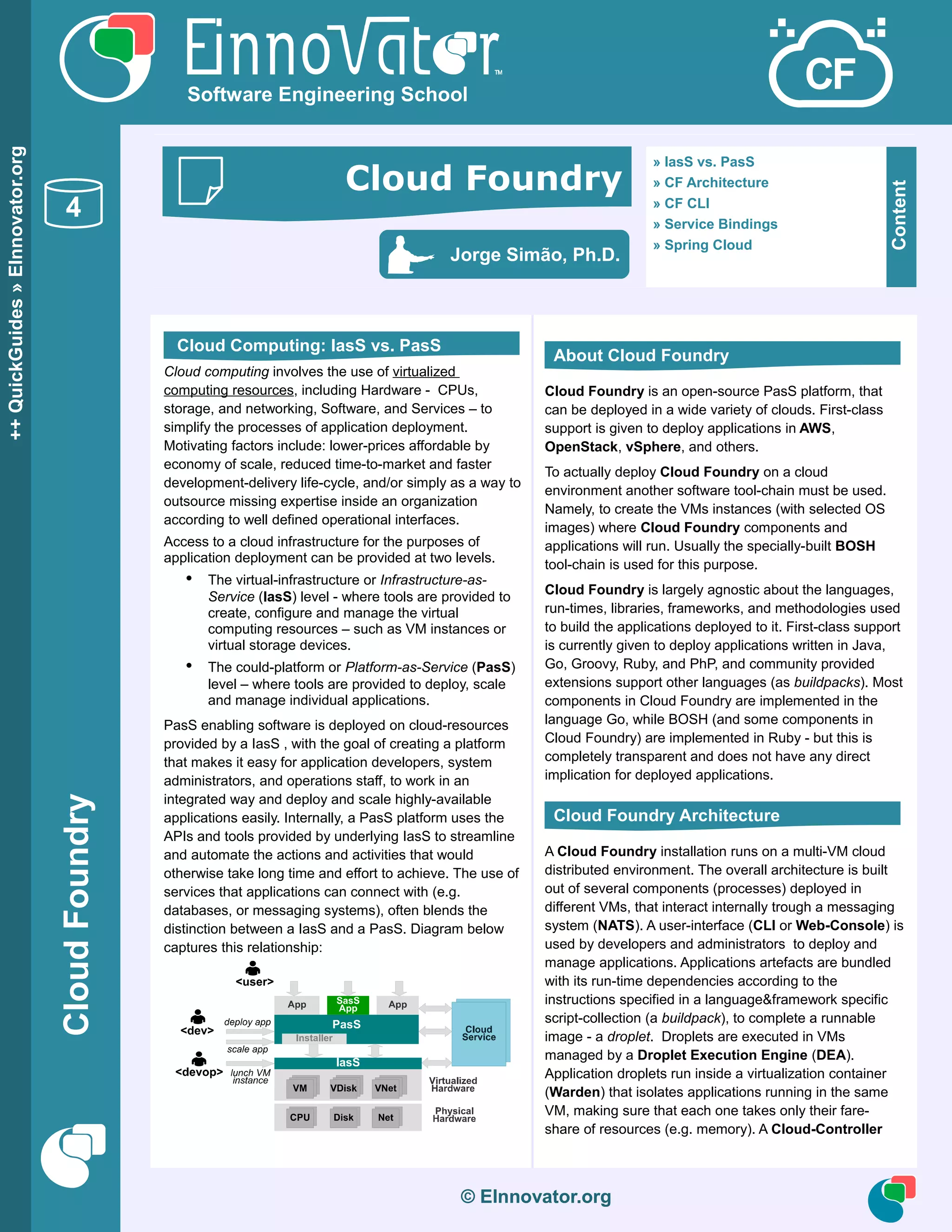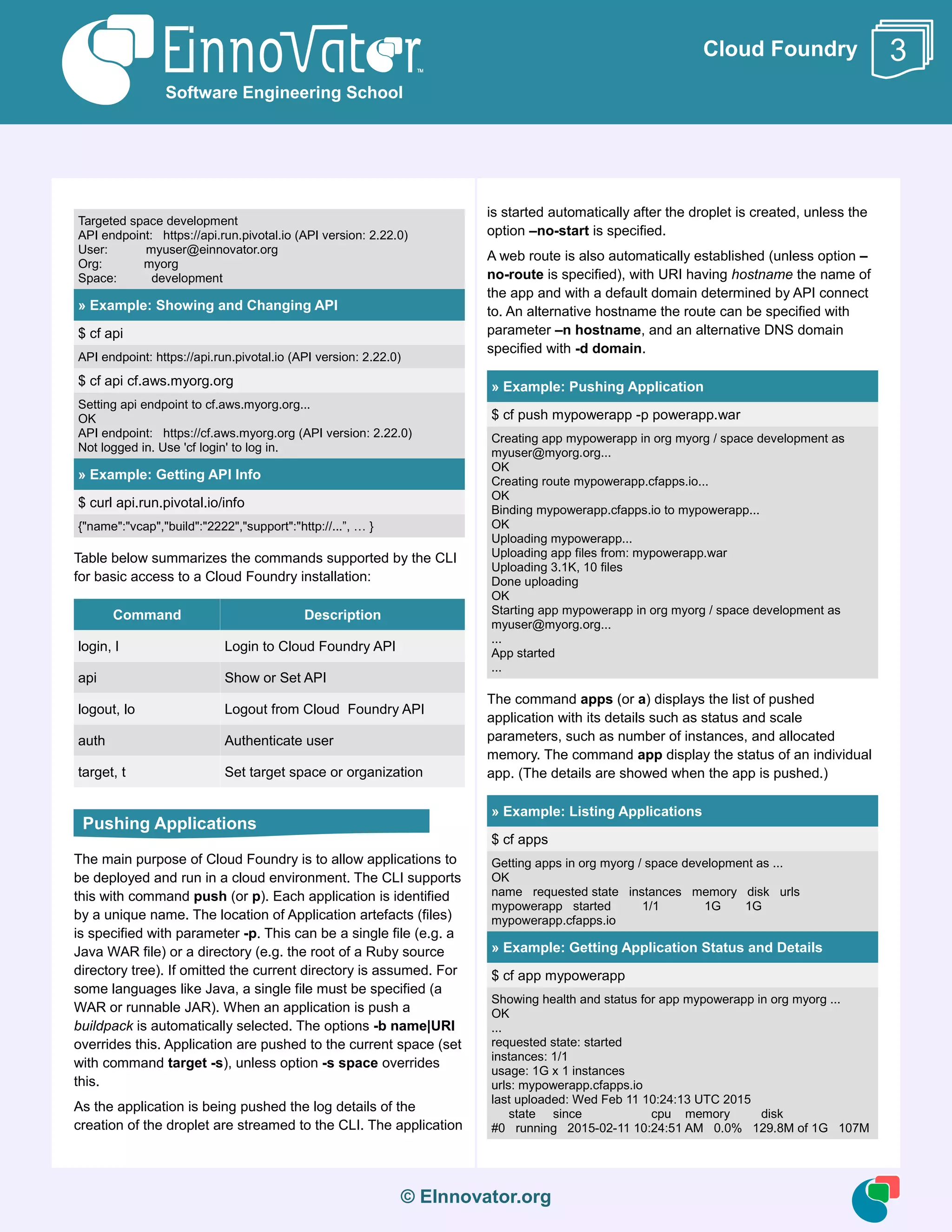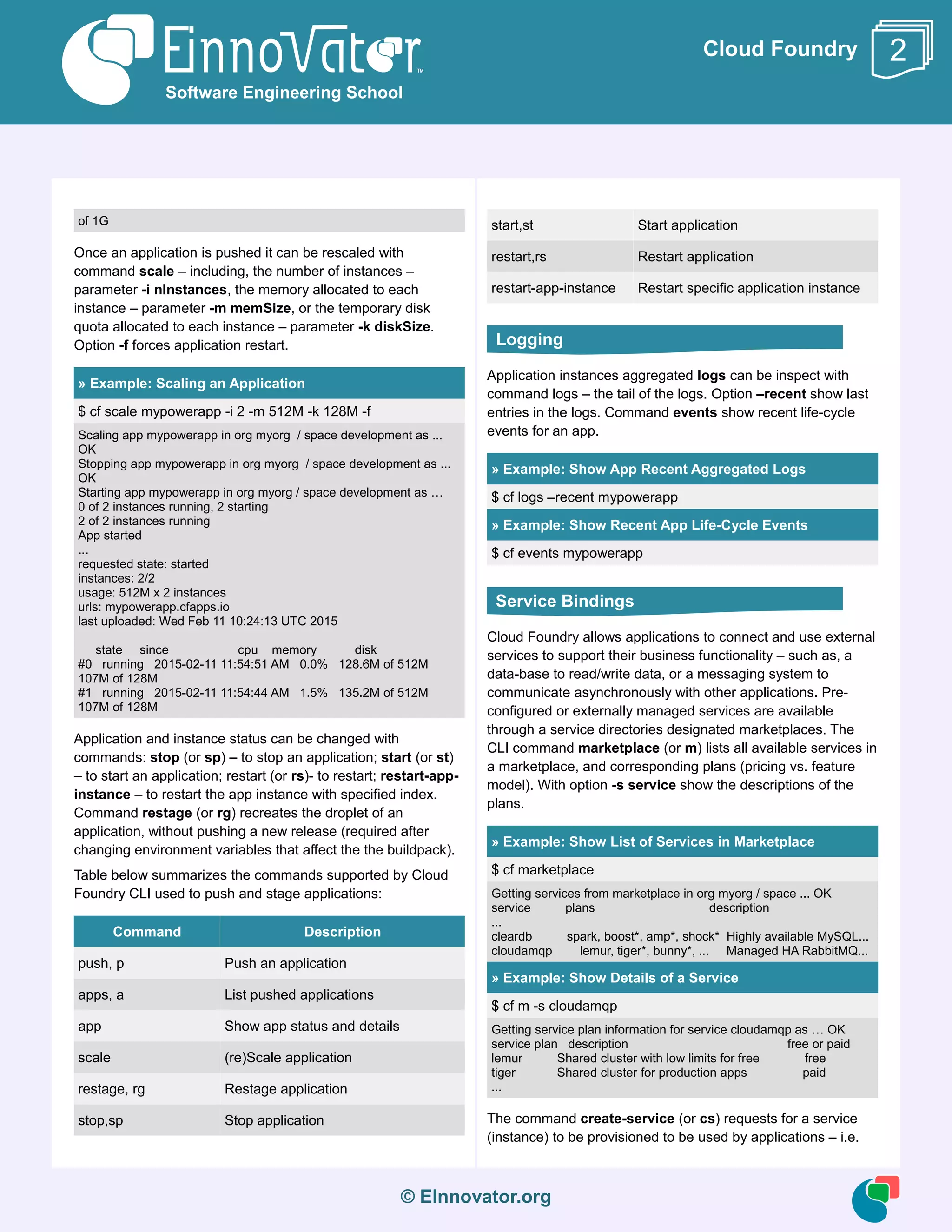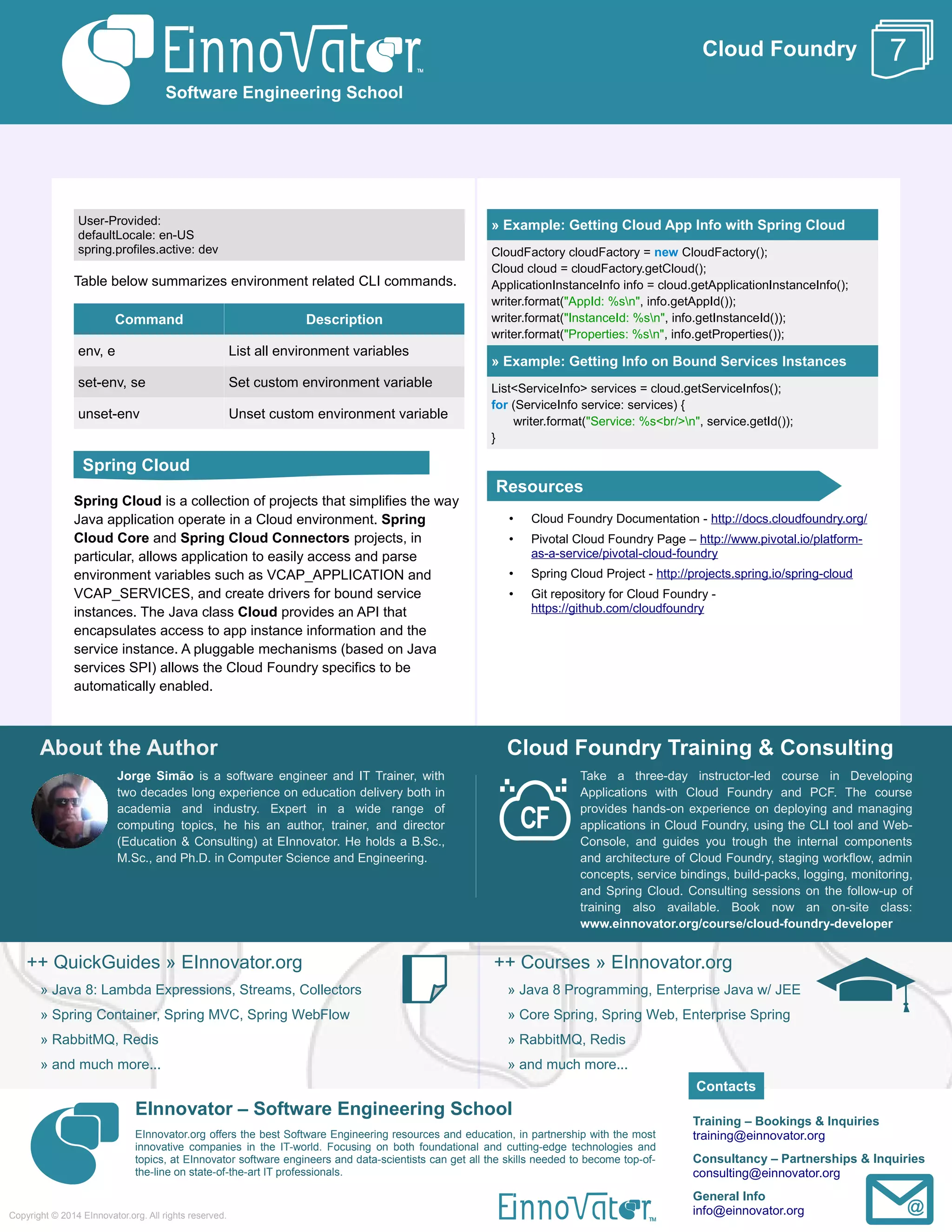Cloud computing involves using virtualized computing resources like hardware, software, and services to simplify application deployment. There are two levels of access to cloud infrastructure: Infrastructure as a Service (IaaS) provides tools to manage virtual resources, and Platform as a Service (PaaS) provides tools to deploy, scale, and manage applications. Cloud Foundry is an open-source PaaS that can be deployed on various cloud infrastructures. It uses BOSH to create the virtual machines where Cloud Foundry components and applications are deployed. The Cloud Foundry CLI is used to push, scale, and manage applications on the platform.

![© EInnovator.org
Cloud Foundry
orchestrates the different action required to stage and control
applications, and provides a REST API that clients (CLI or
Web-Console) can connect with. A database is used to keep all
the meta-data about staged applications and running droplets,
and a blob-store is used to store binary objects such as
applications artefacts and droplets. A Router is used to
dynamically map application URLs to one of the VMs where
application instances are deployed. A Health Manager is
responsible to collect status information about running apps,
and make this information available, so that corrective action
can take place (e.g. replace a missing application instance).
Diagram below illustrates the relationship between Cloud
Foundry components running in a cloud-based distributed
installation.
Whenever an application is pushed to a Cloud Foundry
installation using the CLI, a carefully orchestrated sequence of
steps is followed to make sure the application is staged,
started, scaled, and made accessible. Figure below shows a
time-diagram with these sequence of steps.
Interaction with a Cloud Foundry installation can be done using
a CLI tool (Command Line Interface), named cf. The CLI tool
connects to a Cloud Foundry application controller using a
REST API, and issues commands to push, scale, and
configure applications and services. The CLI can be installed
and run in any of the common OSs (Linux, Mac, Windows),
including/normally from a developer or operator workstation or
laptop.
Running cf without any parameters will prompt it to display the
list of all supported command-line commands organized by
categories. Each command is identified by name, and the most
commonly used ones, also by a single or multi-letter alias.
Optional parameters to commands are specified and identified
by name prefixed by -, while mandatory parameters are
identified positionally just after the command name. The
general syntax of the CLI commands is described below:
» TIP: CLI Command Syntax
$ cf
[env vars] cf [global options] command [args...] [options]
» TIP: Asking for Command Help
$ cf login -h
...
USAGE:
cf login [-a API_URL] [-u USERNAME] [-p PASSWORD] [-o ORG] [-
s SPACE]
The first step to follow to start using the Cloud Foundry CLI is
to specify the URI of the application controller API, and the
user credentials that authenticate the CLI requests. This can
be conveniently done in a single step with command login (or
l). Optional parameters -u and -p are used to specify user
credentials. If omitted, the username/email and password are
asked interactively. Parameter -a is use to specify the URI of
the Cloud Controller REST API endpoint to connect with.
Alternatively, the command api can be use to set (or show) the
API endpoint. In the examples below, we use mostly the
Pivotal API hosted in AWS: api.run.pivotal.io.
» Example: Login to PWS with CF-CLI
$ cf login -u myuser@myorg.org -p “s3cret!” -a
api.run.pivotal.io
API endpoint: https://api.run.pivotal.io
Authenticating...
OK
Targeted org myorg
Software Engineering School
2
Cloud Foundry Workflow
Command Line Interface (CLI)](https://image.slidesharecdn.com/c8da6b1f-56cd-44c1-a78c-89badfb0a2c6-161005231312/75/quickguide-einnovator-4-cloudfoundry-2-2048.jpg)



![© EInnovator.org
Cloud Foundry
bind-service,bs Bind service to application
create-user-provided-
service, cups
create user provided (non
marketplace) service
update-user-provided-
service, uups
update user provided (non
marketplace) service
All the settings specified when an app is pushed can be
conveniently specified in a manifest (configuration) file, written
in YAML syntax. By default, a file named manifest.yml in the
current work directory is used as manifest, unless an
alternative is specified with push option -f. A manifest file can
configure a single or multiple apps. The use of a manifest file
makes the app-name parameter optional in command push –
the name found in the manifest is used. With multiple app
manifest files, omitting the app name in the push command
pushes all apps. If a name is specified, only the app with that
name is pushed. Manifest settings overwrite previous
command settings, but settings in the current push command
overwrite manifest settings.
Application settings are done under field named applications,
whose value is a list of value objects – one per application –
whose field name designates the app. Settings common to all
apps are specified as fields outside the field applications.
[YAML supports both inline and block syntax-style to define
objects. Symbol – is used to define items in list values (block),
or list syntax [ .., .. ] (inline). Fields are defined as name : value
(inline), or with the value in a newline (block).]
» Example: Manifest File for a Single App (manifest.yml)
applications:
- name: mypowerapp
memory: 512M
instances: 2
host: mypowerapp
hosts:
- mightypowerapp
- superpowerapp
path: ./mypowerapp.war
services:
- amqp
- mysql
env:
defaultLocale: en-US
spring.profiles.active: dev,jpa
» Example: Push App with Single App Manifest
$ cf push
» Example: Use Alternative Manifest File
$ cf push -f manifest2.yml
» Example: Manifest File for Multiple Apps
domain: myorg.org
services:
- amqp
- mysql
env:
spring.profiles.active: dev,jpa
applications:
- name: mypowerapp
instances: 2
memory: 512M
path: ./mypowerapp.war
env:
defaultLocale: en-US
- name: otherpowerapp
instances: 1
memory: 512M
path: ./otherpowerapp.war
As it also the case in non-cloud scenarios, application
deployed trough Cloud Foundry have available to them a set of
externally defined settings that can be used to influence its
bootstrap configuration or running behavior – the
Environment. Some environment variables are automatically
set by the Cloud Foundry, including:
• VCAP_APPLICATION – JSON object with application
detail (e.g. name, scaling limits, URIs, etc.)
• VCAP_SERVICES – JSON object with list and details
of services instance an application is bound to.
Customer environment variables are set with command set-
env (or se), and removed with command unset-env. The
command env (or e) show the list of all environment variables.
» Example: Set App Custom Environment Variables
$ cf set-env mypowerapp defaultLocale en-UK
Setting env variable 'spring.profiles.active' to 'dev' for app ...
$ cf set-env mypowerapp spring.profiles.active dev
» Example: Display App Environment Variables
$ cf env mypowerapp
Getting env variables for app mypowerapp in org myorg / space ...OK
System-Provided:
{ "VCAP_SERVICES": {
"cleardb": [ … ],
"cloudamqp": [ … ],
"user-provided": [ { "credentials": { .. } , … }, … ]}
{ "VCAP_APPLICATION": {
"application_name": "mypowerapp",
… }
}
Software Engineering School
6
Manifest Files
Environment Variables](https://image.slidesharecdn.com/c8da6b1f-56cd-44c1-a78c-89badfb0a2c6-161005231312/75/quickguide-einnovator-4-cloudfoundry-6-2048.jpg)
